
United States Army
USinfo | 2013-11-29 15:17
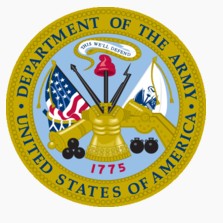
The United States Army is the main branch of the United States Armed Forces responsible for land-based military operations. It is the largest and oldest established branch of the U.S. military, and is one of seven U.S. uniformed services. The modern army has its roots in the Continental Army which was formed on 14 June 1775, before the establishment of the United States, to meet the demands of the American Revolutionary War. The Congress of the Confederation officially created the United States Army on 3 June 1784 after the end of the Revolutionary War to replace the disbanded Continental Army. The army considers itself to be descended from the Continental Army and thus dates its inception from the origins of that force.
The primary mission of the army is "to fight and win our Nation’s wars by providing prompt, sustained land dominance across the full range of military operations and spectrum of conflict in support of combatant commanders." The army is a military service within the Department of the Army, one of the three military departments of the Department of Defense. The army is headed by the Secretary of the Army, and the top military officer in the department is the Chief of Staff of the Army. The highest ranking army officer is currently the Chairman of the Joint Chiefs of Staff. During fiscal year 2010, the Regular Army reported a strength of 561,979 soldiers; the Army National Guard (ARNG) reported 362,015 and the United States Army Reserve (USAR) reported 205,281 putting the combined component strength total at 1,129,275 soldiers.
Mission
The United States Army serves as the land-based branch of the U.S. military. §3062 of Title 10 US Code defines the purpose of the army as:
• preserving the peace and security and providing for the defense of the United States, the Commonwealths and possessions and any areas occupied by the United States
• supporting the national policies
• implementing the national objectives
• overcoming any nations responsible for aggressive acts that imperil the peace and security of the United States
History
This section may need to be cleaned up or summarized. This section has been split to History of the United States Army.
Origins
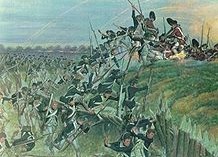
Storming of Redoubt #10 during the Siege of Yorktown.
The Continental Army was created on 14 June 1775 by the Continental Congress as a unified army for the states to fight Great Britain, with George Washington appointed as its commander.The army was initially led by men who had served in the British Army or colonial militias and who brought much of British military heritage with them. As the Revolutionary War progressed, French aid, resources, and military thinking influenced the new army. Prussian assistance and instructors, such as Friedrich Wilhelm von Steuben, also had a strong influence.
George Washington used the Fabian strategy and hit-and-run tactics, hitting where the enemy was weakest, to wear down the British forces and their Hessian mercenary allies. Washington led victories against the British at Trenton and Princeton, and then turned south. With a decisive victory at Yorktown, and the help of the French, the Spanish and the Dutch, the Continental Army prevailed against the British, and with the Treaty of Paris, the independence of the United States was acknowledged.
After the war, though, the Continental Army was quickly disbanded as part of the American distrust of standing armies, and irregular state militias became the new nation's sole ground army, with the exception of a regiment to guard the Western Frontier and one battery of artillery guarding West Point's arsenal. However, because of continuing conflict with Native Americans, it was soon realized that it was necessary to field a trained standing army. The first of these, the Legion of the United States, was established in 1791 and disbanded in 1796.
19th century
The War of 1812, the second and last American war against Britain, was less successful than the Revolution had been. An invasion of Canada failed, and U.S. troops were unable to stop the British from burning the new capital of Washington, D.C.. However, the Regular Army, under Generals Winfield Scott and Jacob Brown, proved they were professional and capable of defeating a British army in the Niagara campaign of 1814. Two weeks after a treaty was signed, though, Andrew Jackson defeated the British invasion of New Orleans. However this had little effect; as per the treaty both sides returned to the status quo.
Between 1815 and 1860, a spirit of Manifest Destiny was common in the U.S., and as settlers moved west the U.S. Army engaged in a long series of skirmishes and battles with Native Americans that the settlers uprooted. The U.S. Army also fought and won the Mexican–American War (1846–1848), which was a defining event for both countries.The U.S. victory resulted in acquisition of territory that eventually became all or parts of the states of California, Nevada, Utah, Colorado, Arizona, Wyoming and New Mexico.
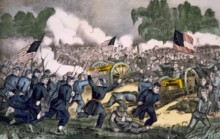
The Battle of Gettysburg, the turning point of the American Civil War
The Civil War was the most costly war for the U.S. in terms of casualties. After most states in the South seceded to form the Confederate States of America, CSA troops opened fire on the Union-held Fort Sumter in Charleston, South Carolina, starting the war. For the first two years Confederate forces solidly defeated the U.S. Army (except for Confederate losses in 1861 at Philippi Races, Rich Mountain, and Carnifax Ferry, and Confederate losses in 1862 at Mill Springs, Fort Henry, Fort Donelson, Shiloh, New Madrid, Memphis, Apache Canyon, Slocum Creek/New Bern, Fair Oaks/Seven Pines, South Mountain, Antietam, Iuka and Corinth[8]), but after the decisive battles of Gettysburg in the east and Vicksburg in the west, combined with superior industrial might and numbers, Union troops fought a brutal campaign through Confederate territory and forced the surrender of the Confederate Army of Northern Virginia at Appomatox Courthouse and the Confederate Army of the Carolinas at Dunham Station in April 1865. The war remains the deadliest conflict in American history, resulting in the deaths of 620,000 soldiers. Based on 1860 census figures, 8% of all white males aged 13 to 43 died in the war, including 6% in the North and 18% in the South.
Following the Civil War, the U.S. Army fought a long battle with Native Americans, who resisted U.S. expansion into the center of the continent. By the 1890s the U.S. saw itself as a potential international player. U.S. victories in the Spanish–American War and the controversial and less well known Philippine–American War, as well as U.S. intervention in Latin America and the Boxer Rebellion, gained America more land and power.
20th century
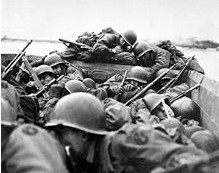
Soldiers from the U.S. Army 89th Infantry Division cross the Rhine River in assault boats, 1945.
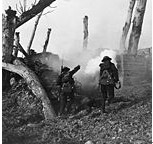
Assault on a German bunker, France, circa 1918
Starting in 1910, the army began acquiring fixed-wing aircraft. In 1910, Mexico was having a civil war, peasant rebels fighting government soldiers. The army was deployed to American towns near the border to ensure safety to lives and property. In 1916, Pancho Villa, a major rebel leader, attacked Columbus, New Mexico, prompting a U.S. intervention in Mexico until 7 February 1917. They fought the rebels and the Mexican federal troops until 1918. The United States joined World War I in 1917 on the side of Britain, France, Russia, Italy and other allies. U.S. troops were sent to the front and were involved in the push that finally broke through the German lines. With the armistice in November 1918, the army once again decreased its forces.
The U.S. joined World War II after the Japaneseattack on Pearl Harbor. On the European front, U.S. Army troops formed a significant portion of the forces that captured North Africa and Sicily. On D-Day and in the subsequent liberation of Europe and defeat of Nazi Germany, millions of U.S. Army troops played a central role. In the Pacific, army soldiers participated alongside U.S. Marines in capturing the Pacific Islands from Japanese control. Following the Axis surrenders in May (Germany) and August (Japan) of 1945, army troops were deployed to Japan and Germany to occupy the two defeated nations. Two years after World War II, the Army Air Forces separated from the army to become the United States Air Force in September 1947 after decades of attempting to separate. Also, in 1948 the army was desegregated.
However, the end of World War II set the stage for the East–West confrontation known as the Cold War. With the outbreak of the Korean War, concerns over the defense of Western Europe rose. Two corps, V and VII, were reactivated under Seventh United States Army in 1950 and American strength in Europe rose from one division to four. Hundreds of thousands of U.S. troops remained stationed in West Germany, with others in Belgium, the Netherlands and the United Kingdom, until the 1990s in anticipation of a possible Soviet attack.

Soldiers of the 2nd Infantry Division man a machine gun during the Korean War
During the Cold War, American troops and their allies fought Communist forces in Korea and Vietnam. The Korean War began in 1950, when the Soviets walked out of a U.N. Security meeting, removing their possible veto. Under a United Nations umbrella, hundreds of thousands of U.S. troops fought to prevent the takeover of South Korea by North Korea, and later, to invade the northern nation. After repeated advances and retreats by both sides, and the PRCPeople's Volunteer Army's entry into the war, the Korean Armistice Agreement returned the peninsula to the status quo in 1953.
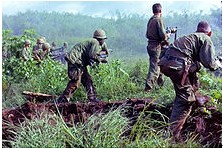
An infantry patrol moves up to assault the last Viet Cong position at Dak To, South Vietnam after an attempted overrun of the artillery position by the Viet Cong during Operation Hawthorne
The Vietnam War is often regardedas a low point for the army due to the use of drafted personnel, the unpopularity of the war with the American public, and frustrating restrictions placed on the military by US political leaders. While American forces had been stationed in the Republic of Vietnam since 1959, in intelligence & advising/training roles, they did not deploy in large numbers until 1965, after the Gulf of Tonkin Incident. American forces effectively established and maintained control of the "traditional" battlefield, however they struggled to counter the guerrilla hit and run tactics of the communist Viet Cong and the North Vietnamese Army. On a tactical level, American soldiers (and the US military as a whole) did not lose a sizable battle.
The Total Force Policy was adopted by Chief of Staff of the Army General Creighton Abrams in the aftermath of the Vietnam War and involves treating the three components of the army – the Regular Army, the Army National Guard and the Army Reserve as a single force. Believing that no U.S. president should be able to take the United States (and more specifically the US Army) to war without the support of the American people, General Abrams intertwined the structure of the three components of the army in such a way as to make extended operations impossible, without the involvement of both the Army National Guard and the Army Reserve.
The 1980s was mostly a decade of reorganization. The army converted to an all-volunteer force with greater emphasis on training and technology. The Goldwater-Nichols Act of 1986 created unified combatant commands bringing the army together with the other four military services under unified, geographically organized command structures. The army also played a role in the invasions of Grenada in 1983 (Operation Urgent Fury) and Panama in 1989 (Operation Just Cause).
By 1989 Germany was nearing reunification and the Cold War was coming to a close. Army leadership reacted by starting to plan for a reduction in strength. By November 1989 Pentagon briefers were laying out plans to reduce army endstrength by 23%, from 750,000 to 580,000.A number of incentives such as early retirement were used. In 1990 Iraqinvaded its smaller neighbor, Kuwait, and U.S. land forces, quickly deployed to assure the protection of Saudi Arabia. In January 1991 Operation Desert Storm commenced, a U.S.-led coalition which deployed over 500,000 troops, the bulk of them from U.S. Army formations, to drive out Iraqi forces. The campaign ended in total victory, as Western coalition forces routed the Iraqi Army, organized along Soviet lines, in just one hundred hours.
After Desert Storm, the army did not see major combat operations for the remainder of the 1990s but did participate in a number of peacekeeping activities. In 1990 the Department of Defense issued guidance for "rebalancing" after a review of the Total Force Policy,[15] but in 2004, Air War College scholars concluded the guidance would reverse the Total Force Policy which is an "essential ingredient to the successful application of military force."
21st century

US and Iraqi Soldiers patrol borders in Iraq.
After the September 11 attacks, and as part of the Global War on Terror, U.S. and NATOcombined arms (i.e. army, navy, air force, marine, special operations) forces invaded Afghanistan in 2001, displacing the Taliban government.
The army led the combined U.S. and allied Invasion of Afghanistan in 2001, and Iraq in 2003. In the following years the mission changed from conflict between regular militaries to counterinsurgency, resulting in the deaths of more than 4,000 U.S service members (as of March 2008) and injuries to thousands more.and 23,813 insurgents were killed in Iraq between 2003–2011. The lack of stability in the theater of operations has led to longer deployments for Regular Army as well as Reserve and Guard troops.
The army's chief modernization plan was the FCS program. Many systems were canceled and the remaining were swept into the BCT modernization program.
Organization
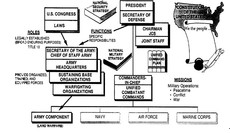
organization chart
Army components
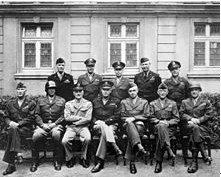
U.S. Generals, World War II, Europe:
back row (left to right): Stearley, Vandenberg, Smith, Weyland, Nugent;
front row: Simpson, Patton, Spaatz, Eisenhower, Bradley, Hodges, Gerow.
The task of organizing the U.S. Army commenced in 1775.In the first one hundred years of its existence, the United States Army was maintained as a small peacetime force to man permanent forts and perform other non-wartime duties such as engineering and construction works. During times of war, the U.S. Army was augmented by the much larger United States Volunteers which were raised independently by various state governments. States also maintained full-time militias which could also be called into the service of the army.
By the twentieth century, the U.S. Army had mobilized the U.S. Volunteers on four separate occasions during each of the major wars of the nineteenth century. During World War I, the "National Army" was organized to fight the conflict, replacing the concept of U.S. Volunteers.It was demobilized at the end of World War I, and was replaced by the Regular Army, the Organized Reserve Corps, and the State Militias. In the 1920s and 1930s, the "career" soldiers were known as the "Regular Army" with the "Enlisted Reserve Corps" and "Officer Reserve Corps" augmented to fill vacancies when needed.
In 1941, the "Army of the United States" was founded to fight World War II. The Regular Army, Army of the United States, the National Guard, and Officer/Enlisted Reserve Corps (ORC and ERC) existed simultaneously. After World War II, the ORC and ERC were combined into the United States Army Reserve. The Army of the United States was re-established for the Korean War and Vietnam War and was demobilized upon the suspension of the Draft.
Currently, the army is divided into the Regular Army, the Army Reserve, and the Army National Guard.The army is also divided into major branches such as Air Defense Artillery, Infantry, Aviation, Signal Corps, Corps of Engineers, and Armor. Prior to 1903 members of the National Guard were considered state soldiers unless federalized by the President. Since the Militia Act of 1903 all National Guard soldiers have held dual status: as National Guardsmen under the authority of the governor of their state and as a reserve of the U.S. Army under the authority of the President.
Since the adoption of the total force policy, in the aftermath of the Vietnam War, reserve component soldiers have taken a more active role in U.S. military operations. Reserve and Guard units took part in the Gulf War, peacekeeping in Kosovo, and the 2003 invasion of Iraq.
[edit] Army commands and army service component commands
| Army commands | Current commander | Location of headquarters |
| United States Army Forces Command (FORSCOM) | GEN David M. Rodriguez | Fort Bragg, North Carolina |
| United States Army Training and Doctrine Command (TRADOC) | GEN Robert W. Cone | Fort Eustis, Virginia |
| United States Army Materiel Command (AMC) | GEN Dennis L. Via | Redstone Arsenal, Alabama |
| Army service component commands | Current commander | Location of headquarters |
| United States Army Africa (USARAF) | MG David R. Hogg | Vicenza, Italy |
| United States Army Central (ARCENT) / US Third Army | LTG Vincent K. Brooks | Shaw Air Force Base, South Carolina |
| United States Army North (ARNORTH) / US Fifth Army | LTG William B. Caldwell | Joint Base San Antonio, Texas |
| United States Army South (ARSOUTH) / US Sixth Army | MG Simeon Trombitas | Joint Base San Antonio, Texas |
| United States Army Europe (USAREUR) / US Seventh Army | LTG Mark Hertling | Campbell Barracks, Heidelberg, Germany |
| United States Army Pacific (USARPAC) | LTG Francis J. Wiercinski | Fort Shafter, Hawaii |
| United States Army Special Operations Command (USASOC) | LTG John F. Mulholland, Jr. | Fort Bragg, North Carolina |
| Surface Deployment and Distribution Command (SDDC) | MG Thomas J.Richardson | Scott AFB, Illinois |
| United States Army Space and Missile Defense Command/ Army Strategic Command (USASMDC/ARSTRAT) | LTG Richard P. Formica | Redstone Arsenal, Alabama |
| Field army headquarters | Current commander | Location of headquarters |
| Eighth United States Army (EUSA) | LTG John D. Johnson | Yongsan Garrison, South Korea |
| Direct reporting units | Current commander | Location of headquarters |
| United States Army Medical Command (MEDCOM) | LTG Patricia D. Horoho | Joint Base San Antonio, Texas |
| United States Army Intelligence and Security Command (INSCOM) | MG Stephen G. Fogarty | Fort Belvoir, Virginia |
| United States Army Criminal Investigation Command (USACIDC) | MG David E. Quantock | Quantico, Virginia |
| United States Army Corps of Engineers (USACE) | LTG Thomas P. Bostick | Washington, D.C. |
| United States Army Military District of Washington (MDW) | MG Michael S. Linnington | Fort McNair, Washington, D.C. |
| United States Army Test and Evaluation Command (ATEC) | MG GenaroDellarocco | Alexandria, Virginia |
| United States Military Academy (USMA) | LTG David H. Huntoon | West Point, New York |
| United States Army Reserve Command (USARC) | LTG Jack C. Stultz | Fort Bragg, North Carolina |
| United States Army Installation Management Command (IMCOM) | LTG Michael Ferriter | Joint Base San Antonio, Texas |
| United States Army Cyber Command (ARCYBER)[27][28] / US Second Army | LTG Rhett Hernandez | Fort Belvoir, Virginia |
Structure
The United States Army is made up of three components: the active component, the Regular Army; and two reserve components, the Army National Guard and the Army Reserve. Both reserve components are primarily composed of part-time soldiers who train once a month, known as battle assemblies or unit training assemblies (UTAs), and conduct two to three weeks of annual training each year. Both the Regular Army and the Army Reserve are organized under Title 10 of the United States Code, while the National Guard is organized under Title 32. While the Army National Guard is organized, trained and equipped as a component of the U.S. Army, when it is not in federal service it is under the command of individual state and territorial governors; the District of Columbia National Guard, however, reports to the U.S. President, not the district's mayor, even when not federalized. Any or all of the National Guard can be federalized by presidential order and against the governor's wishes.
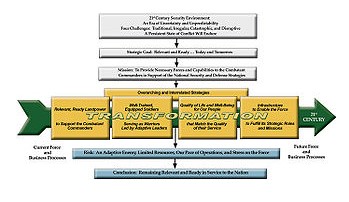
Graphic legend of Army Transformation
The army is led by a civilian Secretary of the Army, who has the statutory authority to conduct all the affairs of the army under the authority, direction and control of the Secretary of Defense.The Chief of Staff of the Army who is the highest-ranked military officer in the army has dual roles; one as the principal military adviser and executive agent for the Secretary of the Army, i.e. its service chief; and secondly as a member of the Joint Chiefs of Staff, a body composed of the service chiefs from each of the four military services belonging to the Department of Defense who advise the President of the United States, the Secretary of Defense, and the National Security Council on operational military matters, under the guidance of the Chairman and Vice Chairman of the Joint Chiefs of Staff.In 1986, the Goldwater-Nichols Act mandated that operational control of the services follows a chain of command from the President to the Secretary of Defense directly to the unified combatant commanders, who have control of all armed forces units in their geographic or function area of responsibility. Thus, the secretaries of the military departments (and their respective service chiefs underneath them) only have the responsibility to organize, train and equip their service components. The army provides trained forces to the combatant commanders for use as directed by the Secretary of Defense.
Through 2013, the army is shifting to six geographical commands that will line up with the six geographical unified combatant commands (COCOM):
• United States Army Central headquartered at Shaw Air Force Base, South Carolina
• United States Army North headquartered at Fort Sam Houston, Texas
• United States Army South headquartered at Fort Sam Houston, Texas
• United States Army Europe headquartered at Campbell Barracks, Germany
• United States Army Pacific headquartered at Fort Shafter, Hawaii
• United States Army Africa headquartered at Vicenza, Italy
The army is also changing its base unit from divisions to brigades. When finished, the active army will have increased its combat brigades from 33 to 48, with similar increases in the National Guard and Reserve forces. Division lineage will be retained, but the divisional headquarters will be able to command any brigade, not just brigades that carry their divisional lineage. The central part of this plan is that each brigade will be modular, i.e. all brigades of the same type will be exactly the same, and thus any brigade can be commanded by any division. There will be three major types of ground combat brigades:
• Armor brigades will have around 3,700 troops and be equivalent to a mechanized infantry or tank brigade.
• Stryker brigades will have around 3,900 troops and be based on the Stryker family of vehicles.
• Infantry brigades will have around 3,300 troops and be equivalent to a light infantry or airborne brigade.
In addition, there are combat support and service support modular brigades. Combat support brigades include aviation (CAB) brigades, which will come in heavy and light varieties, fires (artillery) brigades, and battlefield surveillance brigades. Combat service support brigades include sustainment brigades and come in several varieties and serve the standard support role in an army.
Regular combat maneuver organizations
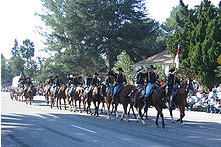
1st Cavalry DivisionFort Hood, TX at the 2007 Rose Parade
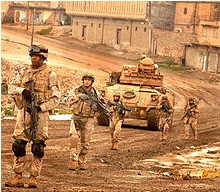
3rd Armored Cavalry Regiment soldiers on patrol in Iraq.
The U.S. Army currently consists of 10 active divisions as well as several independent units. The force is in the process of contracting after several years of growth, with up to eight combat brigades scheduled to deactivate due to budget cuts.
Within the Army National Guard and United States Army Reserve there are a further eight divisions, over fifteen maneuver brigades, additional combat support and combat service support brigades, and independent cavalry, infantry, artillery, aviation, engineer, and support battalions. The Army Reserve in particular provides virtually all psychological operations and civil affairs units.
| Name | Headquarters | Subunits |
| 1st Armored Division | Fort Bliss, Texas | 2nd and 4th Heavy BCTs, 1st Stryker BCT, 3rd Infantry BCT (Light), and Combat Aviation Brigade (CAB). |
| 1st Cavalry Division | Fort Hood, Texas | 1st, 2nd, 3rd, and 4th Heavy BCTs, and CAB. |
| 1st Infantry Division | Fort Riley, Kansas | 1st and 2nd Heavy BCTs, 4th Infantry BCT (Light), and Combat Aviation Brigade at Fort Riley; 3rd Infantry BCT (Light) at Fort Knox, Kentucky. |
| 2nd Infantry Division | Camp Red Cloud, South Korea | 1st Heavy BCT at Camp Casey and CAB at Camp Humphreys, South Korea; 2nd, 3rd, and 4th Stryker BCTs at Joint Base Lewis-McChord, Washington. |
| 3rd Infantry Division | Fort Stewart, Georgia | 1st and 2nd Heavy BCTs, and 4th Infantry BCT (Light) at Fort Stewart, Georgia; 3rd Heavy BCT at Fort Benning, Georgia, and CAB at Hunter Army Airfield, Georgia. |
| 4th Infantry Division | Fort Carson, Colorado | 1st, 2nd, and 3rd Heavy BCTs, and 4th Infantry BCT (Light). CAB forming in 2013. |
| 10th Mountain Division | Fort Drum, New York | 1st, 2nd, 3rd Infantry BCTs (Light), and CAB at Fort Drum; 4th Infantry BCT (Light) at Fort Polk, Louisiana. |
| 25th Infantry Division | Schofield Barracks, Hawaii | 3rd Infantry BCT (Light) and 2nd Stryker BCT at Schofield Barracks; CAB at Wheeler Army Airfield; 1st Stryker BCT at Fort Wainwright, Alaska, and 4th Infantry BCT (Airborne) at Fort Richardson, Alaska. |
| 82nd Airborne Division | Fort Bragg, North Carolina | 1st, 2nd, 3rd, and 4th Infantry BCTs (Airborne), and CAB. |
| 101st Airborne Division | Fort Campbell, Kentucky | 1st, 2nd, 3rd and 4th Infantry BCTs (Air Assault), two CABs. |
| 170th Infantry Brigade | Baumholder, Germany | Two mechanized infantry battalions, one M1A1 Abrams battalion, one self-propelled 155mm field artillery battalion, one combat engineer battalion, and one Brigade Support Battalion. |
| 172nd Infantry Brigade | Grafenwöhr, Germany | Two mechanized infantry battalions, one M1A1 Abrams battalion, one self-propelled 155mm field artillery battalion, one combat engineer battalion. |
| 173rd Airborne Brigade | Vicenza, Italy | Infantry BCT (Airborne): Two airborne infantry battalions in Vicenza, Italy. One cavalry squadron in Schweinfurt, Germany. One special troops battalion, one airborne field artillery battalion, and one support battalion at Warner Barracks in Bamberg, Germany. |
| 2nd Cavalry Regiment | Vilseck, Germany | Stryker BCT: 6 squadrons: 1st, 2nd and 3rd (Stryker Infantry), 4th (RSTA), Fires Squadron (3x6 155mm towed artillery), and Regimental Support Squadron; 5 separate troops: Regimental Headquarters, Military Intelligence, Signal, Engineer and Anti-Armor. |
| 3rd Cavalry Regiment | Fort Hood, Texas | Stryker BCT: 6 squadrons: 1st, 2nd and 3rd (Stryker Infantry), 4th (RSTA), Fires Squadron (3x6 155mm towed artillery), and Regimental Support Squadron; 5 separate troops: Regimental Headquarters, Military Intelligence, Signal, Engineer and Anti-Armor. |
| 11th Armored Cavalry Regiment | Fort Irwin, California | Serves as the Opposing Force (OPFOR) at the National Training Center (NTC). Multi-compo Generating Force HBCT. |
Special operations forces
US Army Special Operations Command (Airborne):
| Name | Headquarters | Structure and purpose |
| Special Forces(Green Berets) | Fort Bragg, North Carolina | Seven groups (five active, two National Guard) capable of unconventional warfare, foreign internal defense, special reconnaissance, direct action, and counter-terrorism. |
| John F. Kennedy Special Warfare Center and School | Fort Bragg, North Carolina | Entry-level and advanced selection, education and training for Special Forces, Civil Affairs and Military Information Support Operations Soldiers. Advanced skills include regional and language education, and sniper, combat diving and HALO. Home of Joint Special Operations Medical Training Center, Special Forces Warrant Officer Institute and David K. Thuma NCO Academy. |
| 75th Ranger Regiment(Rangers) | Fort Benning, Georgia | Three maneuver battalions and one special troops battalion of elite airborne infantry specializing in direct action raids and airfield seizures. |
| 160th Special Operations Aviation Regiment(Night Stalkers) | Fort Campbell, Kentucky | Four battalions, providing helicopter aviation support for general purpose forces and special operations forces. |
| 4th Military Information Support Group | Fort Bragg, North Carolina | Psychological operations unit, three battalions. |
| 8th Military Information Support Group | Fort Bragg, North Carolina | Psychological operations unit, three battalions. |
| 95th Civil Affairs Brigade | Fort Bragg, North Carolina | Four battalions. |
| 528th Sustainment Brigade (Special Operations) (Airborne) | Fort Bragg, North Carolina | |
| 1st SFOD-D(Delta Force) | Fort Bragg, North Carolina | Elite special operations and counter-terrorism unit. Its operators are chosen primarily from Special Forces groups and the Ranger Regiment. |
Equipment
Weapons
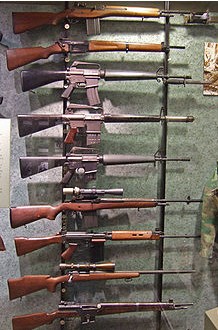
An M16, an AR-10 and a semi-automatic AR-15 "Sporter" along with other Vietnam War era rifles.
Individual weapons
The army employs various individual weapons to provide light firepower at short ranges. The most common weapons used by the army are the compact variant of the M16 rifle, the M4 carbine, as well as the 7.62x51 mm variant of the FN SCAR for Army Rangers. The primary sidearm in the U.S. Army is the 9 mm M9 pistol.
Many units are supplemented with a variety of specialized weapons, including the M249 SAW (squad automatic weapon), to provide suppressive fire at the fire-team level. Indirect fire is provided by the M203 grenade launcher. The M1014 Joint Service Combat Shotgun or the Mossberg 590 Shotgunare used for door breaching and close-quarters combat. The M14EBR is used by long-range marksmen, and the M107 Long Range Sniper Rifle, the M24 Sniper Weapon System, and the M110 Semi-Automatic Sniper Rifle is used by snipers. Hand grenades, such as the M67 fragmentation grenade and M18 smoke grenade, are also used.
Crew served weapons
The army employs various crew-served weapons to provide heavy firepower at ranges exceeding that of individual weapons.
The M240 is the army's standard medium machine gun. The M2 heavy machine gun is generally used as a vehicle-mounted machine gun. In the same way, the 40 mm MK 19 grenade machine gun is mainly used by motorized units.
The army uses three types of mortar for indirect fire support when heavier artillery may not be appropriate or available. The smallest of these is the 60 mm M224, normally assigned at the infantry company level. At the next higher echelon, infantry battalions are typically supported by a section of 81 mm M252 mortars. The largest mortar in the army's inventory is the 120 mm M120/M121, usually employed by mechanized units.
Fire support for light infantry units is provided by towed howitzers, including the 105 mm M119A1 and the 155 mm M777 (which will replace the M198).
The army utilizes a variety of direct-fire rockets and missiles to provide infantry with an anti-armor capability. The AT4 is an unguided rocket that can destroy armor and bunkers at ranges up to 500 meters. The FIM-92 Stinger is a shoulder-launched, heat seeking anti-aircraft missile. The FGM-148 Javelin and BGM-71 TOW are anti-tank guided missiles.
Vehicles

Humvee
The army's most common vehicle is the High Mobility Multipurpose Wheeled Vehicle (HMMWV), commonly called the Humvee, which is capable of serving as a cargo/troop carrier, weapons platform, and ambulance, among many other roles. While they operate a wide variety of combat support vehicles, one of the most common types centers on the family of HEMTT vehicles. The M1A2 Abrams is the army's main battle tank, while the M2A3 Bradley is the standard infantry fighting vehicle. Other vehicles include the M3A3 Bradley, the Stryker, and the M113armored personnel carrier, and multiple types of Mine Resistant Ambush Protected (MRAP) vehicles.
The U.S. Army's principal artillery weapons are the M109A6 Paladin self-propelled howitzer and the M270 Multiple Launch Rocket System (MLRS), both mounted on tracked platforms and assigned to heavy mechanized units.
While the U.S. Army operates a few fixed-wing aircraft, it mainly operates several types of rotary-wing aircraft. These include the AH-64 Apacheattack helicopter, the OH-58D Kiowa Warrior armed reconnaissance/light attack helicopter, the UH-60 Black Hawk utility tactical transport helicopter, and the CH-47 Chinook heavy-lift transport helicopter.
Fixed wing aircraft used by the US Army are for non-front line combat and light transport roles. The army relies on the United States Air Force for airlift capabilities.
Uniforms
The Army Combat Uniform, or ACU, currently features a digital Universal Camouflage Pattern (UCP) and is designed for use in woodland, desert, and urban environments. However, Soldiers operating in Afghanistan are being issued a fire-resistant ACU with the "MultiCam" pattern, officially known as Operation Enduring Freedom Camouflage Pattern or "OCP".
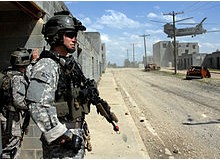
The standard garrison service uniform is known as Army Greens or Class-As and has been worn by all officers and enlisted personnel since its introduction in 1956 when it replaced earlier olive drab (OD) and khaki (and tan worsted or TW) uniforms worn between the 1950s and 1985. The Army Blue uniform, dating back to the mid-19th century, is currently the Army's formal dress uniform, but in 2014, it will replace the Army Green and the Army White uniforms (a uniform similar to the Army Green uniform, but worn in tropical postings) and will become the new Army Service Uniform, which will function as both a garrison uniform (when worn with a white shirt and necktie) and a dress uniform (when worn with a white shirt and either a necktie for parades or a bow tie for after six or black tie events). The beret (having been permanently replaced with the patrol cap) is no longer worn with the new ACU for garrison duty. After years of complaints that it wasn't suited well for most work conditions, Army Chief of Staff General Martin Dempsey eliminated it for wear with the ACU in June 2011 with exception to soldiers who are currently in an airborne unit (maroon beret), Rangers (tan beret), and Special Forces (green beret) and with the Army Service Uniform for non-ceremonial functions. Unit commanders may still direct the wear of patrol caps in these units in training environments or motorpools.
Personal armor in most units is the Improved Outer Tactical Vest and the Advanced Combat Helmet.
Tents
The army has relied heavily on tents to provide the various facilities they need while on deployment. The most common tent uses for the military are temporary barracks (sleeping quarters), DFAC buildings (dining facilities), forward operating bases (FOBs), after action review (AAR), tactical operations center (TOC), morale, welfare, and recreation (MWR) facilities, and security checkpoints. Furthermore, most of these tents are set up and operated through the support of Natick Soldier Systems Center.

The U.S. military is beginning to use a more modern tent called the deployable rapid assembly shelter or DRASH. In 2008, DRASH became part of the Army's Standard Integrated Command Post System.
Branch establishment
The U.S. Army was officially founded on 14 June 1775, when the Continental Congress authorized enlistment of riflemen to serve the United Colonies for one year. Each branch of the army has a different branch insignia.
Basic branches
• Infantry, 14 June 1775
Ten companies of riflemen were authorized by a resolution of the Continental Congress on 14 June 1775. However, the oldest Regular Army infantry regiment, the 3rd Infantry Regiment, was constituted on 3 June 1784, as the First American Regiment.
• Adjutant General's Corps, 16 June 1775
The post of Adjutant General was established 16 June 1775, and has been continuously in operation since that time. The Adjutant General's Department, by that name, was established by the act of 3 March 1812, and was redesignated the Adjutant General's Corps in 1950.
• Corps of Engineers, 16 June 1775
Continental Congress authority for a "Chief Engineer for the Army" dates from 16 June 1775. A corps of engineers for the United States was authorized by the Congress on 11 March 1789. The Corps of Engineers as it is known today came into being on 16 March 1802, when the President was authorized to "organize and establish a Corps of Engineers … that the said Corps … shall be stationed at West Point in the State of New York and shall constitute a Military Academy." A Corps of Topographical Engineers, authorized on 4 July 1838, was merged with the Corps of Engineers on March 1863.
• Finance Corps, 16 June 1775
The Finance Corps is the successor to the old Pay Department, which was created in June 1775. The Finance Department was created by law on 1 July 1920. It became the Finance Corps in 1950.
• Quartermaster Corps, 16 June 1775
The Quartermaster Corps, originally designated the Quartermaster Department, was established on 16 June 1775. While numerous additions, deletions, and changes of function have occurred, its basic supply and service support functions have continued in existence.
• Field Artillery, 17 November 1775
The Continental Congress unanimously elected Henry Knox "Colonel of the Regiment of Artillery" on 17 November 1775. The regiment formally entered service on 1 January 1776.
• Armor, 12 June 1776
The Armor Branch traces its origin to the Cavalry. A regiment of cavalry was authorized to be raised by the Continental Congress Resolve of 12 December 1776. Although mounted units were raised at various times after the Revolution, the first in continuous service was the United States Regiment of Dragoons, organized in 1833. The Tank Service was formed on 5 March 1918. The Armored Force was formed on 10 July 1940. Armor became a permanent branch of the army in 1950.
• Ordnance Corps, 14 May 1812
The Ordnance Department was established by act of Congress on 14 May 1812. During the Revolutionary War, ordnance material was under supervision of the Board of War and Ordnance. Numerous shifts in duties and responsibilities have occurred in the Ordnance Corps since colonial times. It acquired its present designation in 1950. Ordnance soldiers and officers provide maintenance and ammunition support.
• Signal Corps, 21 June 1860
The Signal Corps was authorized as a separate branch of the army by act of Congress on 3 March 1863. However, the Signal Corps dates its existence from 21 June 1860, when Congress authorized the appointment of one signal officer in the army, and a War Department order carried the following assignment: "Signal Department – Assistant Surgeon Albert J. Myer to be Signal Officer, with the rank of Major, 27 June 1860, to fill an original vacancy."
• Chemical Corps, 28 June 1918
The Chemical Warfare Service was established on 28 June 1918, combining activities that until then had been dispersed among five separate agencies of government. It was made a permanent branch of the Regular Army by the National Defense Act of 1920. In 1945, it was re-designated the Chemical Corps.
• Military Police Corps, 26 September 1941
A Provost Marshal General's Office and Corps of Military Police were established in 1941. Prior to that time, except during the Civil War and World War I, there was no regularly appointed Provost Marshal General or regularly constituted Military Police Corps, although a "Provost Marshal" can be found as early as January 1776, and a "Provost Corps" as early as 1778.
• Transportation Corps, 31 July 1942
The history of the Transportation Corps starts with World War I. Prior to that time, transportation operations were chiefly the responsibility of the Quartermaster General. The Transportation Corps, essentially in its present form, was organized on 31 July 1942. The Transportation Corps is headquartered at Fort Eustis, Virginia.
• Military Intelligence Corps, 1 July 1962
Intelligence has been an essential element of army operations during war as well as during periods of peace. In the past, requirements were met by personnel from the Army Intelligence and Army Security Reserve branches, two-year obligated tour officers, one-tour levies on the various branches, and Regular Army officers in the specialization programs. To meet the army's increased requirement for national and tactical intelligence, an Intelligence and Security Branch was established effective 1 July 1962, by General Order No. 38, on 3 July 1962. On 1 July 1967, the branch was re-designated as Military Intelligence.
• Air Defense Artillery, 20 June 1968
The Air Defense Artillery separated from the field artillery and was established as a basic branch on 20 June 1968, per General Order 25, 14 June 1968.
• Aviation, 12 April 1983
Following the establishment of the U.S. Air Force as a separate service in 1947, the army began to develop further its own aviation assets (light planes and rotary wing aircraft) in support of ground operations. The Korean War gave this drive impetus, and the war in Vietnam saw its fruition, as army aviation units performed a variety of missions, including reconnaissance, transport, and fire support. After the war in Vietnam, the role of armed helicopters as tank destroyers received new emphasis. In recognition of the growing importance of aviation in army doctrine and operations, aviation became a separate branch on 12 April 1983.
• Special Forces, 9 April 1987
The first special forces unit in the Army was formed on 11 June 1952, when the 10th Special Forces Group was activated at Fort Bragg, North Carolina. A major expansion of special forces occurred during the 1960s, with a total of eighteen groups organized in the Regular Army, Army Reserve, and Army National Guard. As a result of renewed emphasis on special operations in the 1980s, the Special Forces Branch was established as a basic branch of the army effective 9 April 1987, by General Order No. 35, 19 June 1987. Special forces are part of U.S. special operations forces
• Civil Affairs Corps, 16 October 2006
The Civil Affairs/Military Government Branch in the Army Reserve Branch was established as a special branch on 17 August 1955. Subsequently redesignated the Civil Affairs Branch on 2 October 1955, it has continued its mission to provide guidance to commanders in a broad spectrum of activities ranging from host-guest relationships to the assumption of executive, legislative, and judicial processes in occupied or liberated areas. Became a basic branch effective 16 October 2006 per General Order 29, on 12 January 2007.
• Psychological Operations, 16 October 2006
Established as a basic branch effective 16 October 2006 per General Order 30, 12 January 2007. Name will be changed to Military Information Support Operations.
• Logistics, 1 January 2008
Established by General Order 6, 27 November 2007.Consists of multi-functional logistics officers in the rank of captain and above, drawn from the Ordnance, Quartermaster and Transportation Corps.
Special branches
• Army Medical Department, 27 July 1775
The Army Medical Department and the Medical Corps trace their origins to 27 July 1775, when the Continental Congress established the army hospital headed by a "Director General and Chief Physician." Congress provided a medical organization of the army only in time of war or emergency until 1818, which marked the inception of a permanent and continuous Medical Department. The Army Organization Act of 1950 renamed the Medical Department as the Army Medical Service. In June 1968, the Army Medical Service was re-designated the Army Medical Department. The Medical Department has the following branches:
• Medical Corps, 27 July 1775
• Army Nurse Corps, 2 February 1901
• Dental Corps, 3 March 1911
• Veterinary Corps, 3 June 1916
• Medical Service Corps, 30 June 1917
• Army Medical Specialist Corps, 16 April 1947
• Chaplain Corps, 29 July 1775
The legal origin of the Chaplain Corps is found in a resolution of the Continental Congress, adopted 29 July 1775, which made provision for the pay of chaplains. The Office of the Chief of Chaplains was created by the National Defense Act of 1920.
• Judge Advocate General's Corps, 29 July 1775
The Office of Judge Advocate of the army may be deemed to have been created on 29 July 1775, and has generally paralleled the origin and development of the American system of military justice. The Judge Advocate General Department, by that name, was established in 1884. Its present designation as a corps was enacted in 1948.
Share this page



















